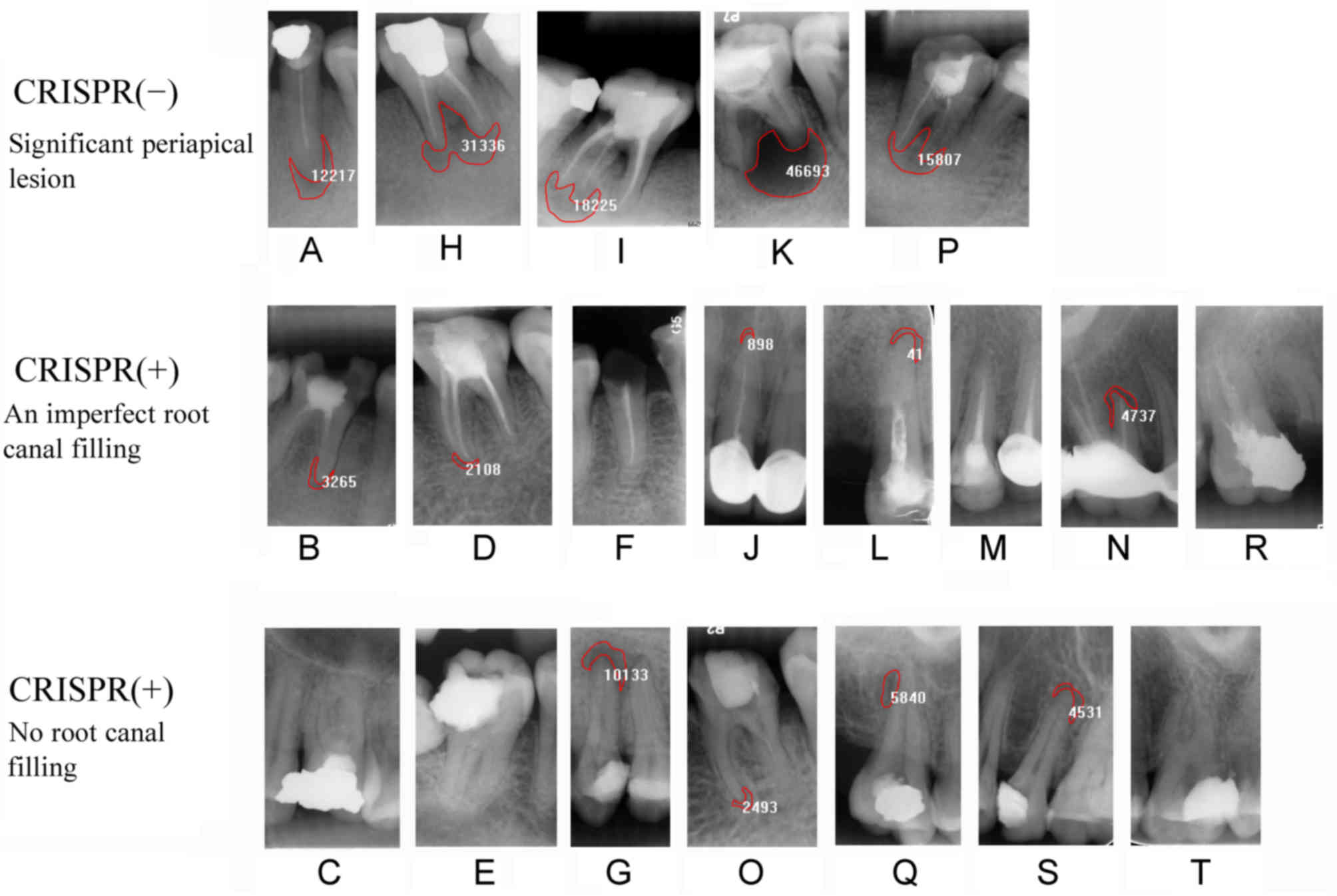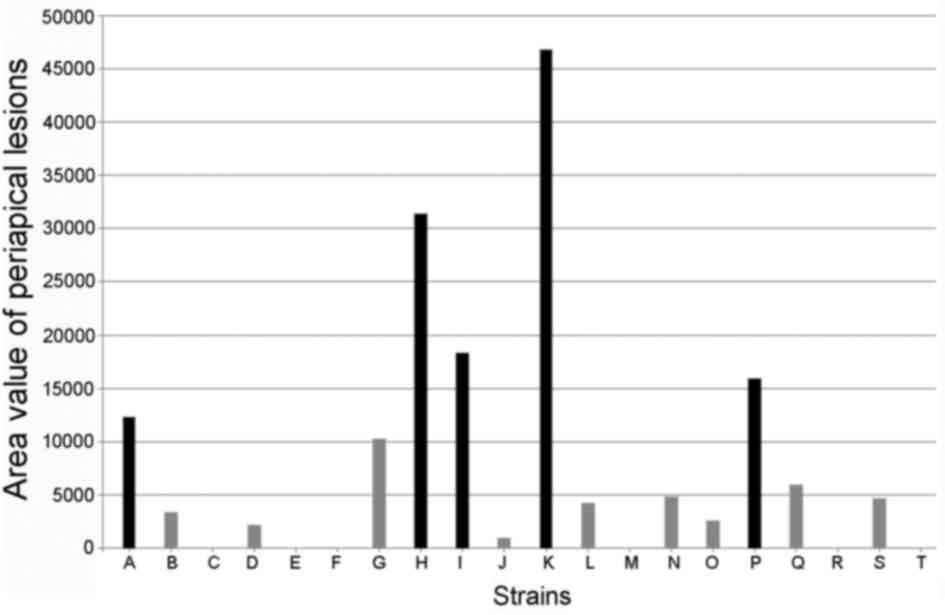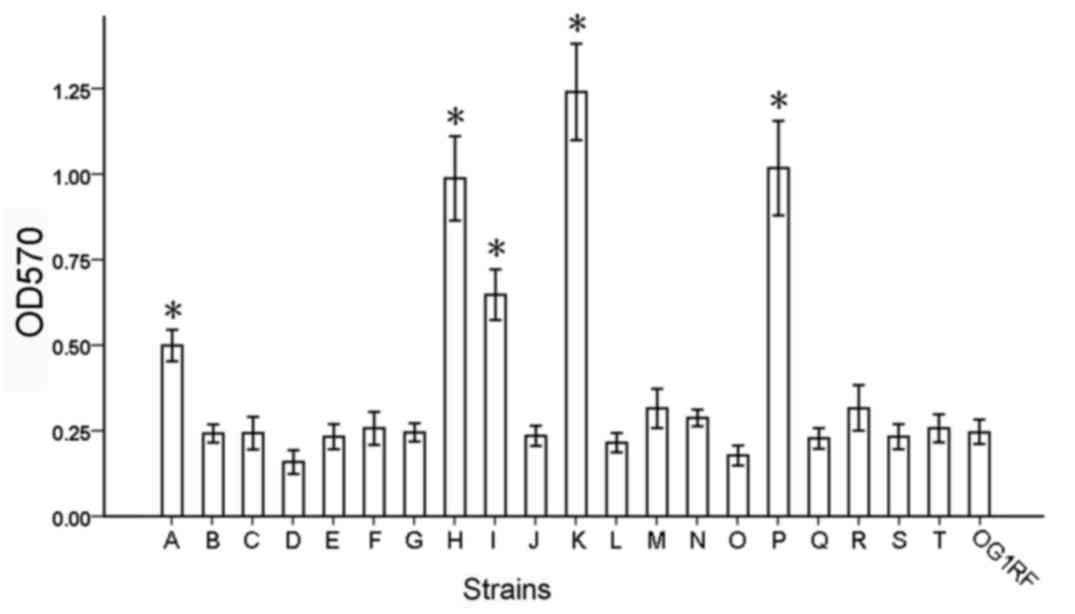|
1
|
Sakamoto M, Siqueira JF Jr, Rocas IN and
Benno Y: Molecular analysis of the root canal microbiota associated
with endodontic treatment failures. Oral Microbiol Immunol.
23:275–281. 2008. View Article : Google Scholar : PubMed/NCBI
|
|
2
|
Siqueira JF Jr and Rocas IN: Diversity of
endodontic microbiota revisited. J Dent Res. 88:969–981. 2009.
View Article : Google Scholar : PubMed/NCBI
|
|
3
|
Zoletti GO, Siqueira JF Jr and Santos KR:
Identification of Enterococcus faecalis in root-filled teeth
with or without periradicular lesions by culture-dependent and
-independent approaches. J Endod. 32:722–726. 2006. View Article : Google Scholar : PubMed/NCBI
|
|
4
|
Siqueira JF Jr and Rocas IN: Polymerase
chain reaction-based analysis of microorganisms associated with
failed endodontic treatment. Oral Surg Oral Med Oral Pathol Oral
Radiol Endod. 97:85–94. 2004. View Article : Google Scholar : PubMed/NCBI
|
|
5
|
Rocas IN, Siqueira JF Jr and Santos KR:
Association of Enterococcus faecalis with different forms of
periradicular diseases. J Endod. 30:315–320. 2004. View Article : Google Scholar : PubMed/NCBI
|
|
6
|
Stuart CH, Schwartz SA, Beeson TJ and
Owatz CB: Enterococcus faecalis: Its role in root canal
treatment failure and current concepts in retreatment. J Endod.
32:93–98. 2006. View Article : Google Scholar : PubMed/NCBI
|
|
7
|
Liu H, Wei X, Ling J, Wang W and Huang X:
Biofilm formation capability of Enterococcus faecalis cells
in starvation phase and its susceptibility to sodium hypochlorite.
J Endod. 36:630–635. 2010. View Article : Google Scholar : PubMed/NCBI
|
|
8
|
Figdor D, Davies JK and Sundqvist G:
Starvation survival, growth and recovery of Enterococcus
faecalis in human serum. Oral Microbiol Immunol. 18:234–239.
2003. View Article : Google Scholar : PubMed/NCBI
|
|
9
|
Barrangou R and Marraffini LA: CRISPR-Cas
systems: Prokaryotes upgrade to adaptive immunity. Mol Cell.
54:234–244. 2014. View Article : Google Scholar : PubMed/NCBI
|
|
10
|
Molloy S: Bacterial genetics: Hitting the
CRISPR target. Nat Rev Microbiol. 10:376–377. 2012. View Article : Google Scholar : PubMed/NCBI
|
|
11
|
Palmer KL, Kos VN and Gilmore MS:
Horizontal gene transfer and the genomics of enterococcal
antibiotic resistance. Curr Opin Microbiol. 13:632–639. 2010.
View Article : Google Scholar : PubMed/NCBI
|
|
12
|
Palmer KL and Gilmore MS:
Multidrug-resistant enterococci lack CRISPR-cas. MBio.
1:e002272010. View Article : Google Scholar : PubMed/NCBI
|
|
13
|
Palmer KL, Godfrey P, Griggs A, Kos VN,
Zucker J, Desjardins C, Cerqueira G, Gevers D, Walker S, Wortman J,
et al: Comparative genomics of enterococci: Variation in
Enterococcus faecalis, clade structure in E. faecium
and defining characteristics of E. gallinarum and E.
casseliflavus. MBio. 3:e00311–e00318. 2012. View Article : Google Scholar
|
|
14
|
Paulsen IT, Banerjei L, Myers GS, Nelson
KE, Seshadri R, Read TD, Fouts DE, Eisen JA, Gill SR, Heidelberg
JF, et al: Role of mobile DNA in the evolution of
vancomycin-resistant Enterococcus faecalis. Science.
299:2071–2074. 2003. View Article : Google Scholar : PubMed/NCBI
|
|
15
|
Burley KM and Sedgley CM: CRISPR-Cas, a
prokaryotic adaptive immune system, in endodontic, oral and
multidrug-resistant hospital-acquired Enterococcus faecalis.
J Endod. 38:1511–1515. 2012. View Article : Google Scholar : PubMed/NCBI
|
|
16
|
Zhang Q, Rho M, Tang H, Doak TG and Ye Y:
CRISPR-Cas systems target a diverse collection of invasive mobile
genetic elements in human microbiomes. Genome Biol. 14:R402013.
View Article : Google Scholar : PubMed/NCBI
|
|
17
|
Lindenstrauss AG, Pavlovic M, Bringmann A,
Behr J, Ehrmann MA and Vogel RF: Comparison of genotypic and
phenotypic cluster analyses of virulence determinants and possible
role of CRISPR elements towards their incidence in Enterococcus
faecalis and Enterococcus faecium. Syst Appl Microbiol.
34:553–560. 2011. View Article : Google Scholar : PubMed/NCBI
|
|
18
|
Tong Z, Ling J, Lin Z, Li X and Mu Y: The
effect of MTADN on 10 Enterococcus faecalis isolates and
biofilm: an in vitro study. J Endod. 39:674–678. 2013. View Article : Google Scholar : PubMed/NCBI
|
|
19
|
Tong Z, Zhang Y, Ling J, Ma J, Huang L and
Zhang L: An in vitro study on the effects of nisin on the
antibacterial activities of 18 antibiotics against Enterococcus
faecalis. PLoS One. 9:e892092014. View Article : Google Scholar : PubMed/NCBI
|
|
20
|
Makarova KS, Haft DH, Barrangou R, Brouns
SJ, Charpentier E, Horvath P, Moineau S, Mojica FJ, Wolf YI,
Yakunin AF, et al: Evolution and classification of the CRISPR-Cas
systems. Nat Rev Microbiol. 9:467–477. 2011. View Article : Google Scholar : PubMed/NCBI
|
|
21
|
Andrup L: Conjugation in gram-positive
bacteria and kinetics of plasmid transfer. APMIS Suppl. 84:47–55.
1998. View Article : Google Scholar : PubMed/NCBI
|
|
22
|
Weigel LM, Clewell DB, Gill SR, Clark NC,
McDougal LK, Flannagan SE, Kolonay JF, Shetty J, Killgore GE and
Tenover FC: Genetic analysis of a high-level vancomycin-resistant
isolate of Staphylococcus aureus. Science. 302:1569–1571.
2003. View Article : Google Scholar : PubMed/NCBI
|
|
23
|
Sundqvist G, Figdor D, Persson S and
Sjögren U: Microbiologic analysis of teeth with failed endodontic
treatment and the outcome of conservative re-treatment. Oral Surg
Oral Med Oral Pathol Oral Radiol Endod. 85:86–93. 1998. View Article : Google Scholar : PubMed/NCBI
|
|
24
|
Peciuliene V, Balciuniene I, Eriksen HM
and Haapasalo M: Isolation of Enterococcus faecalis in
previously root-filled canals in a lithuanian population. J Endod.
26:593–595. 2000. View Article : Google Scholar : PubMed/NCBI
|
|
25
|
Zehnder M and Guggenheim B: The mysterious
appearance of enterococci in filled root canals. Int Endod J.
42:277–287. 2009. View Article : Google Scholar : PubMed/NCBI
|
|
26
|
Marraffini LA: CRISPR-Cas immunity against
phages: Its effects on the evolution and survival of bacterial
pathogens. PLoS Pathog. 9:e10037652013. View Article : Google Scholar : PubMed/NCBI
|
|
27
|
Barrangou R: CRISPR-Cas systems and
RNA-guided interference. Wiley Interdiscip Rev RNA. 4:267–278.
2013. View Article : Google Scholar : PubMed/NCBI
|
|
28
|
Singla MG, Garg A and Gupta S: MTAD in
endodontics: an update review. Oral Surg Oral Med Oral Pathol Oral
Radiol Endod. 112:e70–e76. 2011. View Article : Google Scholar : PubMed/NCBI
|
|
29
|
Kanisavaran ZM: Chlorhexidine gluconate in
endodontics: An update review. Int Dent J. 58:247–257. 2008.
View Article : Google Scholar : PubMed/NCBI
|
|
30
|
Mohammadi Z: Sodium hypochlorite in
endodontics: An update review. Int Dent J. 58:329–341. 2008.
View Article : Google Scholar : PubMed/NCBI
|
|
31
|
Duggan JM and Sedgley CM: Biofilm
formation of oral and endodontic Enterococcus faecalis. J
Endod. 33:815–818. 2007. View Article : Google Scholar : PubMed/NCBI
|
|
32
|
Al-Ahmad A, Müller N, Wiedmann-Al-Ahmad M,
Sava I, Hübner J, Follo M, Schirrmeister J and Hellwig E:
Endodontic and salivary isolates of Enterococcus faecalis
integrate into biofilm from human salivary bacteria cultivated in
vitro. J Endod. 35:986–991. 2009. View Article : Google Scholar : PubMed/NCBI
|
|
33
|
Shankar N, Baghdayan AS and Gilmore MS:
Modulation of virulence within a pathogenicity island in
vancomycin-resistant Enterococcus faecalis. Nature.
417:746–750. 2002. View Article : Google Scholar : PubMed/NCBI
|
|
34
|
Manson JM, Hancock LE and Gilmore MS:
Mechanism of chromosomal transfer of Enterococcus faecalis
pathogenicity island, capsule, antimicrobial resistance and other
traits. Proc Natl Acad Sci USA. 107:pp. 12269–12274. 2010,
View Article : Google Scholar : PubMed/NCBI
|
|
35
|
Hollenbeck BL and Rice LB: Intrinsic and
acquired resistance mechanisms in enterococcus. Virulence.
3:421–433. 2012. View Article : Google Scholar : PubMed/NCBI
|
|
36
|
Franz CM, Huch M, Abriouel H, Holzapfel W
and Gálvez A: Enterococci as probiotics and their implications in
food safety. Int J Food Microbiol. 151:125–140. 2011. View Article : Google Scholar : PubMed/NCBI
|
|
37
|
Dahl A and Bruun NE: Enterococcus
faecalis infective endocarditis: Focus on clinical aspects.
Expert Rev Cardiovasc Ther. 11:1247–1257. 2013. View Article : Google Scholar : PubMed/NCBI
|
|
38
|
Wiedenheft B, Sternberg SH and Doudna JA:
RNA-guided genetic silencing systems in bacteria and archaea.
Nature. 482:331–338. 2012. View Article : Google Scholar : PubMed/NCBI
|












